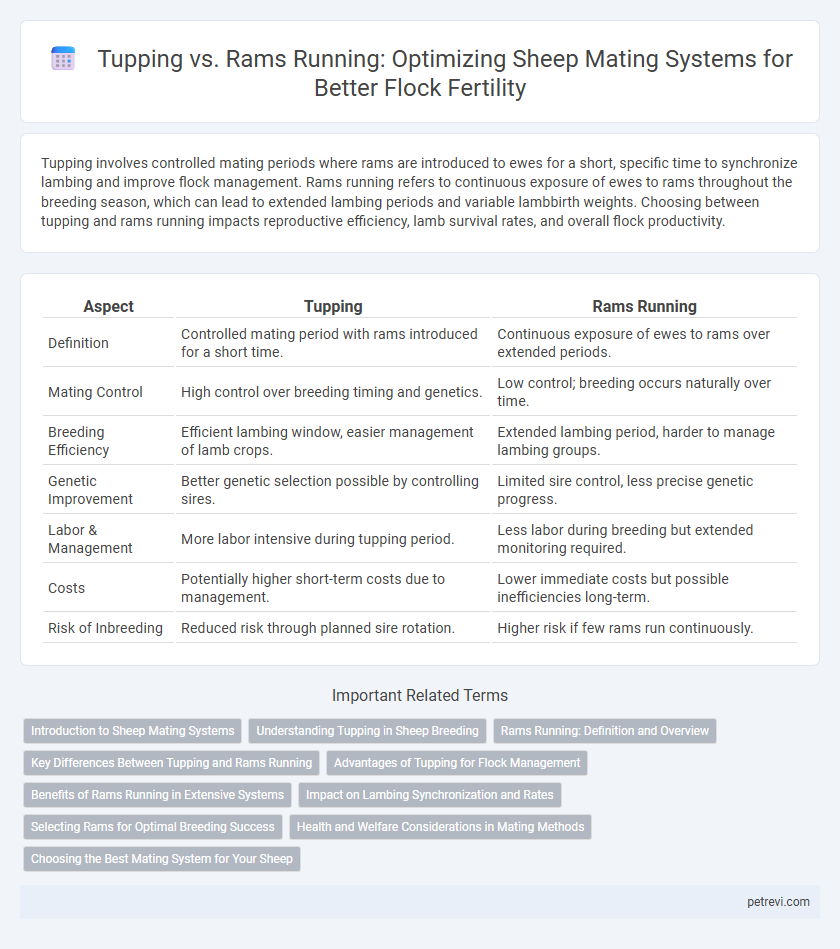Tupping involves controlled mating periods where rams are introduced to ewes for a short, specific time to synchronize lambing and improve flock management. Rams running refers to continuous exposure of ewes to rams throughout the breeding season, which can lead to extended lambing periods and variable lambbirth weights. Choosing between tupping and rams running impacts reproductive efficiency, lamb survival rates, and overall flock productivity.
Table of Comparison
| Aspect | Tupping | Rams Running |
|---|---|---|
| Definition | Controlled mating period with rams introduced for a short time. | Continuous exposure of ewes to rams over extended periods. |
| Mating Control | High control over breeding timing and genetics. | Low control; breeding occurs naturally over time. |
| Breeding Efficiency | Efficient lambing window, easier management of lamb crops. | Extended lambing period, harder to manage lambing groups. |
| Genetic Improvement | Better genetic selection possible by controlling sires. | Limited sire control, less precise genetic progress. |
| Labor & Management | More labor intensive during tupping period. | Less labor during breeding but extended monitoring required. |
| Costs | Potentially higher short-term costs due to management. | Lower immediate costs but possible inefficiencies long-term. |
| Risk of Inbreeding | Reduced risk through planned sire rotation. | Higher risk if few rams run continuously. |
Introduction to Sheep Mating Systems
Sheep mating systems primarily consist of tupping and rams running, each designed to optimize breeding efficiency and lamb production. Tupping involves controlled exposure of ewes to selected rams during a limited breeding period, ensuring precise genetic management and lambing schedules. Rams running, in contrast, allows rams to roam freely with ewes over an extended time, promoting natural mating behavior but with less control over breeding dates and genetics.
Understanding Tupping in Sheep Breeding
Tupping in sheep breeding refers to the mating period when rams are introduced to ewes for reproduction, typically lasting several weeks to maximize lambing success. This controlled breeding approach contrasts with rams running continuously with the flock, allowing for precise management of lambing dates and improved genetic selection. Understanding tupping enables farmers to optimize ewe fertility, monitor ram performance, and implement targeted breeding strategies for enhanced flock productivity.
Rams Running: Definition and Overview
Rams running refers to the natural mating system where a group of rams is introduced to ewes during the breeding season, allowing rams to compete and mate freely without control or synchronization. This method relies on the rams' natural instincts and dominance hierarchy to ensure successful mating and genetic diversity within the flock. Rams running promotes organic selection but may lead to uneven breeding success compared to controlled systems like tupping.
Key Differences Between Tupping and Rams Running
Tupping involves the controlled introduction of rams to ewes during a defined breeding period, optimizing fertility rates and lambing intervals, while Rams Running allows rams to roam freely with ewes over an extended time, often resulting in less precise mating records and varied lambing timings. Key differences include management control, with tupping providing better synchronization of lambing, and rams running offering lower labor intensity but increased risk of uncontrolled breeding. The choice between these systems impacts genetic planning, flock health monitoring, and overall reproductive efficiency in sheep farming.
Advantages of Tupping for Flock Management
Tupping offers precise control over breeding schedules, enabling efficient management of lambing periods and improving flock uniformity. This method reduces stress on ewes by limiting exposure to rams, which can enhance overall flock health and productivity. Controlled mating during tupping also facilitates better record-keeping and selection for desirable traits, optimizing genetic progress within the flock.
Benefits of Rams Running in Extensive Systems
Rams running in extensive sheep mating systems enhance natural breeding efficiency by allowing rams to mate freely over large pastures, which increases lambing rates and genetic diversity. This method reduces labor and management costs compared to controlled tupping periods, providing a sustainable approach for extensive farming environments. Continuous exposure to rams promotes natural mating behaviors, resulting in healthier and more resilient lambs suited to extensive grazing conditions.
Impact on Lambing Synchronization and Rates
Tupping with controlled introduction of rams enhances lambing synchronization by concentrating mating within a defined period, leading to uniform lamb crops that improve management efficiency and market timing. Rams running continuously in paddocks results in extended lambing periods with less synchronized births, complicating feeding and health interventions. Studies show tupping systems increase lambing rates by reducing the time females spend out of estrus, optimizing reproductive performance compared to rams running freely.
Selecting Rams for Optimal Breeding Success
Selecting rams for optimal breeding success requires evaluating genetic traits, health status, and physical fitness to enhance flock productivity and lambing rates. Tupping ensures controlled mating by introducing a single ram to the ewes for a defined period, while rams running allow multiple rams to breed freely, risking uneven paternity and less selective breeding. Prioritizing rams with superior lineage, disease resistance, and proven fertility boosts the likelihood of robust offspring and improves herd genetics over time.
Health and Welfare Considerations in Mating Methods
Tupping and rams running are common sheep mating systems with distinct health and welfare impacts. Tupping involves controlled exposure of ewes to rams, reducing stress and injury risks, while rams running allows natural mating behavior but may increase aggression and physical harm among sheep. Selecting a mating method requires balancing reproductive efficiency with animal welfare by monitoring flock behavior and health indicators.
Choosing the Best Mating System for Your Sheep
Tupping involves controlled mating periods where rams are introduced to ewes for a specific time, optimizing lambing synchrony and improving flock management. Rams running, or continuous mating, allows rams to stay with ewes year-round, supporting natural breeding cycles but potentially leading to uneven lambing patterns. Selecting the best mating system depends on flock size, management goals, and resources available for monitoring and care.
Tupping vs Rams Running for Sheep Mating System Infographic

 petrevi.com
petrevi.com